Do you have any plans to enhance the customer experience? Do you want to know if and how chatbots can assist you with that?
Currently, 23% of businesses that provide customer care employ AI chatbots. At some time, 80% of people have engaged with a chatbot.

Approximately 69% of all discussions are handled by chatbots, and nearly 70% of all conversations with clients are handled by chatbots in their entirety.
It’s not unusual to see more people using chatbots today. More and more large-scale enterprises are utilizing them to automate various customer-facing processes.
Organizations experience significant cost savings and an increase in efficiency when they rely less on service agents and live agents.
A chatbot: what is it?
Chatbots, sometimes known as conversational agents informally, are software applications that are connected to a variety of platforms to automatically respond to incoming messages or to genuinely start conversations in a completely human sense.
More customers are turning to chatbot virtual assistants to do simple tasks in both business-to-business (B2B) and business-to-consumer (B2C) situations.

When live agents aren’t available, firms can still provide customer service while saving money on overhead and making better use of the time of support personnel.
Chatbots: How do they operate?
How is natural speech produced by a machine? People frequently ask themselves this query when considering the use of chatbots.
The actual mechanism by which chatbots are created and operated is difficult and takes a high level of technical expertise. But the method by which they may talk in a human-like manner is quite intriguing and in reality simple to comprehend.
In a helpdesk, a chatbot functions in the same way as a human. The most crucial stages that the chatbot should take are the capacity to recognize the user’s questions and the ability to gather data and pertinent entities from the user’s queries.
Provide the most relevant answer to the user’s questions once the chatbot has focused on the content of the queries.
Suppose a consumer email asks, “What time does your store open tomorrow morning?” as an example.
The chatbot used to provide an immediate response as a human would, such as “Our store opens at 11 am tomorrow morning and closes at 9 pm,” based on the information that was available.

Three classification techniques are used by chatbots in their operation.
Pattern matching
Bots group text using pattern matching, which prompts clients to respond appropriately. A common structured model of these patterns is the Artificial Intelligence Markup Language (AIML).
A bot can correctly respond in the relevant pattern. Any reference to the linked patterns triggers a response from the bots.
Understanding natural language (NLU)
The capability of the chatbot to understand a human is known as natural language understanding (NLU).
It involves turning language into structured data that a computer can understand. Three distinct principles are used by NLU. Expectations, circumstances, and entities make them up.
Natural language processing (NLP)
Natural language processing (NLP) is a technology that allows bots to convert user-provided text or audio inputs into structured data.
After that, the data is put to use in choosing the best response. Tokenization, sentiment analysis for chatbots, entity recognition, and dependency parsing are a few crucial NLP tasks.
How Do AI Chatbots Operate?
However intimidating the concept of creating your own Conversational AI chatbot may seem with all the talk of artificial intelligence and machine learning, assistance is accessible.
Prior to supplying your chatbot with the data it needs, carefully considers the goals you want to achieve with it. Then, develop a strategy that is well-defined.

Almost half of all marketers consider themselves AI beginners, which is now one of the largest barriers to AI adoption. However, the truth is that anyone can create an AI chatbot; you don’t even need to be a coder or have a Ph.D. in NLP.
An AI chatbot is initially supplied input data, which it then decodes and transforms into a pertinent output. The AI chatbot will therefore strive to provide the best response possible whenever a site visitor asks a question by analyzing their purpose as well as other aspects like tone and sentiment.
The AI chatbot requires access to a huge amount of conversational data in order to accomplish this. Because of this, AI chatbots must undergo training during which a programmer teaches the bot how to comprehend the context of a person’s remarks.
This comprehension enables the chatbot to respond to complex questions in a way that feels conversational and genuine.
Significant characteristics of chatbots with AI:
- The context and aim of complicated interactions can be understood by conversational bots, who then attempt to respond with more pertinent information.
- For a deeper understanding of client emotions, AI bots use predictive intelligence and sentiment analysis.
- Personalized dialogues are made possible by machine learning bots, which learn from user behavior.
Why Chatbots Are Important?
You can create chatbots to respond in a certain way every time, recognize phrases in messages that cause particular responses to be sent, or even utilize machine learning to adjust the response based on the circumstances.

In order to understand how crucial chatbots are, consider some of the following importance:
24×7 availability
Bots are always accessible to engage with customers and provide quick replies to their frequent inquiries. The primary benefit of using chatbots is having 24-hour customer service available.
Having 24/7 help without the need for people to be on call is one of the fundamental benefits of using a chatbot.
Without requiring long wait times or disturbing a representative at three in the morning, chatbots enable brands to interact with their audiences 24/7 and offer prompt responses throughout the year.
Reduce customer wait times
21% of customers think chatbots are the quickest way to get in touch with a company. The use of bots is a more intelligent way to guarantee that clients get the quick response they need without having to wait in line.
Eliminate Interactive Voice Response (IVR) Systems
Chatbots with machine learning is significantly more adaptable and capable, giving users the impression that their voice is genuinely being heard.
In light of this, one of the chatbots’ top advantages is their ability to solve problems effectively.
Gathering of data
The volume of incoming messages is enormous, the velocity is high owing to the capacity to deliver quick information, and there is undoubtedly variety because each customer is different.
Chatbots deal with all of these features. When using chatbots, all the data from each interaction is saved, building a repository of genuine data that can be utilized to improve conversational agents or even product development when taking user feedback into account.
Businesses can also improve their knowledge bases to include the information users desire, rather than merely the information the brand wants to share, through chatbots and their data repositories.
That is how you successfully close the gap in customer experience.
Save customer service costs
Chatbots will help businesses save more than a billion annually by reducing the cost of providing customer assistance.
Bots are simple to scale, which reduces the cost of infrastructure, additional staffing, and other customer service expenses.
Businesses can communicate automatically with their consumers by using the Webkul CS-Cart Chatbot add-on. Users can message the chatbot, and it can reply to them.
Automate lead qualifying and sales
Using chatbots, you can prequalify leads and route them to the appropriate team for additional nurturing. Increasing lead generation and conversion rates through immediate consumer connection.
Depending on the answers, chatbots can be trained to pose certain prequalification questions. Furthermore, the route leads to the appropriate team for further nurturing.
A software application created by Webkul specifically for the Facebook Messenger system is called Facebook Chatbot. It enables companies to communicate with their clients automatically.
Automation of the sales funnel would benefit from this, freeing up sales representatives to work on time-consuming duties like closing transactions.
How do companies use chatbots?
The employment of chatbots in B2C and B2B sales and services has just lately transitioned from their long-standing use in instant messaging apps and online interactive games.

The following are some ways that businesses can use chatbots:
Online shopping:
Sales teams can utilize chatbots in these settings to respond to simple product queries or to give useful details that customers can subsequently look up, such as shipping costs and availability.
Service to customers:
Chatbots can assist service agents in responding to repetitious queries in service departments. An example would be for a customer service representative to give the chatbot the order number and inquire as to the shipping date.
Usually, when a conversation becomes too complicated, a chatbot will pass the call or text to a customer support representative.
Virtual assistants:
Virtual assistants can be created using chatbots. From Apple, Amazon, Google, and Microsoft, virtual assistants are accessible.
Apps like Apple’s Siri and Microsoft’s Cortana, as well as hardware like the Google Home or Amazon’s Echo with Alexa, all serve as personal chatbots.
Wrapping Up:
Is using chatbots beneficial for my business? is the essential question to think about.
This is not a straightforward yes or no question since it calls for a thorough examination of your company, its operations, and—most importantly—the average volume of incoming digital inquiries.
Several analysts are predicting that chatbots will keep growing in popularity. A new level of text- and voice-enabled user experiences will be introduced in the future, and this will revolutionize CX.
Additionally, chatbots will have more strength as AI and ML continue to advance.
These advancements may also have an impact on data collecting and provide deeper customer insights that influence prospective buyers’ behavior.
Voice services are now common and crucial elements of the IT ecosystem. It’s becoming more and more common for developers to create voice-based chatbots that can serve as conversational agents, comprehend a wide variety of languages, and respond in those same languages.
Support
So, that was much about How Chatbots Improve the Customer Experience? for any queries or doubts reach out to us at [email protected], you can also raise a ticket at our HelpDesk System.


Be the first to comment.